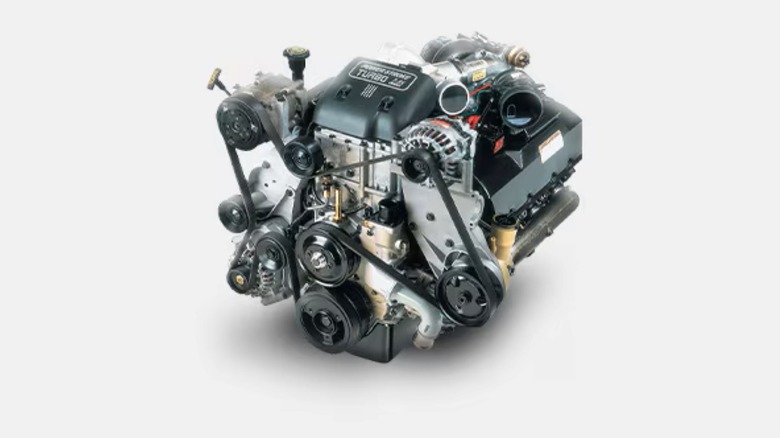What Years Did International Make The 7.3 Power Stroke Diesel Engine?
Ford is one of the most respected American "Big Three" car brands, and in the 7.3 Power Stroke, it found itself an engine that similarly enjoys considerable prestige. The 7.3 arrived on the scene in 1994 — about five years after the 5.9 Cummins launched in the Dodge heavy-duty trucks — but soon became the head honcho of its generation, to the point it eventually developed into one of the best diesel engines ever built. This was due in part to its decent power output, simplicity, ruggedness, and ease of maintenance.
While that sounds like something you would expect from Ford, the 7.3 Power Stroke was actually built by its service parts supplier, Navistar International. The engine was based on the Navistar T444E turbo-diesel V8 and featured direct injection, a wastegate turbocharger, an air-to-air intercooler, and hydraulically actuated electronic unit injection (HUEI) fuel injectors, which helped it emit the least NOx emissions of any diesel engine at the time. The 7.3 was in production between 1994 and 2003, with around 2 million units made at International's Indianapolis plant.
In that time, it featured in heavy-duty Ford trucks such as the F-250 and F-350 Super Duty, producing between 210–275 horsepower and 425–525 lb-ft of torque, funneled to the wheels through either a ZF 5-speed manual or an E40D 4-speed automatic transmission (versions made between 1999-2003 came with 4R110 four-speed automatic and ZF S6-650 six-speed manual transmission options). With that, the 7.3 Power Stroke could tow anywhere from 8,000 to 13,900 pounds, which is decent considering the era. However, even with its popularity, reliability, impressive performance, and huge towing figures, Ford decided to discontinue the 7.3 Power Stroke diesel engine from its lineup due to stricter emissions regulations.
The 7.3 Power Stroke diesel engine was considered virtually indestructible
The 7.3 Power Stroke diesel engine is renowned among Blue Oval followers for being one of the most reliable Ford engines. This reputation is owed mainly to its high-quality materials, which include cast iron block and cylinder heads, steel crankshaft, forged steel connecting rods, and cast aluminum pistons — all of which tend to hold up well even under high-stress conditions. Well-maintained examples are known to run smoothly for 300,000 miles or more, with phrases such as "built like a tank" often used to describe the engine.
However, as with any car engine, there are some common problems that owners and future buyers should be aware of. One of the most common fault areas of the 7.3 Power Stroke diesel engine is the camshaft position sensor (CPS), which can fail and cause stalling. In addition, the aluminum filter housing could crack, resulting in a fuel leak. Not to mention, the fuel filter and water separator have also been known to fail, among other, less common issues. That being said, the engine is dependable overall, though dependability will vary depending on the model year you're looking at. We previously covered the best and worst years for the Ford 7.3 Power Stroke diesel engine, with the 1999 model emerging as the best engine in general.
Which Power Stroke diesel engine replaced the 7.3?
Following the discontinuation of the O.G. 7.3 Power Stroke engine, Ford lined up the 6.0 Power Stroke as its replacement in 2003. The 6.0 was a completely new engine that, in addition to replacing the outgoing 7.3 powerplant, was engineered to be powerful, efficient, and compliant with the stringent NOx emissions standards that were being established for diesels at the time. Hence, it featured a more compact design along with emission control devices such as exhaust gas recirculation (EGR), a variable-geometry turbocharger, and HEUI fuel injectors to boost performance as well as lower fuel consumption and emissions.
Power output stood at 325 hp and 560–570 lb-ft of torque, all handled by either a five-speed 5R110W Torqshift automatic or ZF6 six-speed manual transmission. The new engine also proved more capable than its predecessor, with a tow rating ranging from 12,500 pounds to 19,200 pounds. Sadly, the 6.0 oil-burner is known to be problematic at times. Among the most common problems with the Ford 6.0 Power Stroke diesel is head gasket failure, which can occur due to head bolt issues. EGR valve, EGR cooler, and oil cooler failures are also widely reported.


